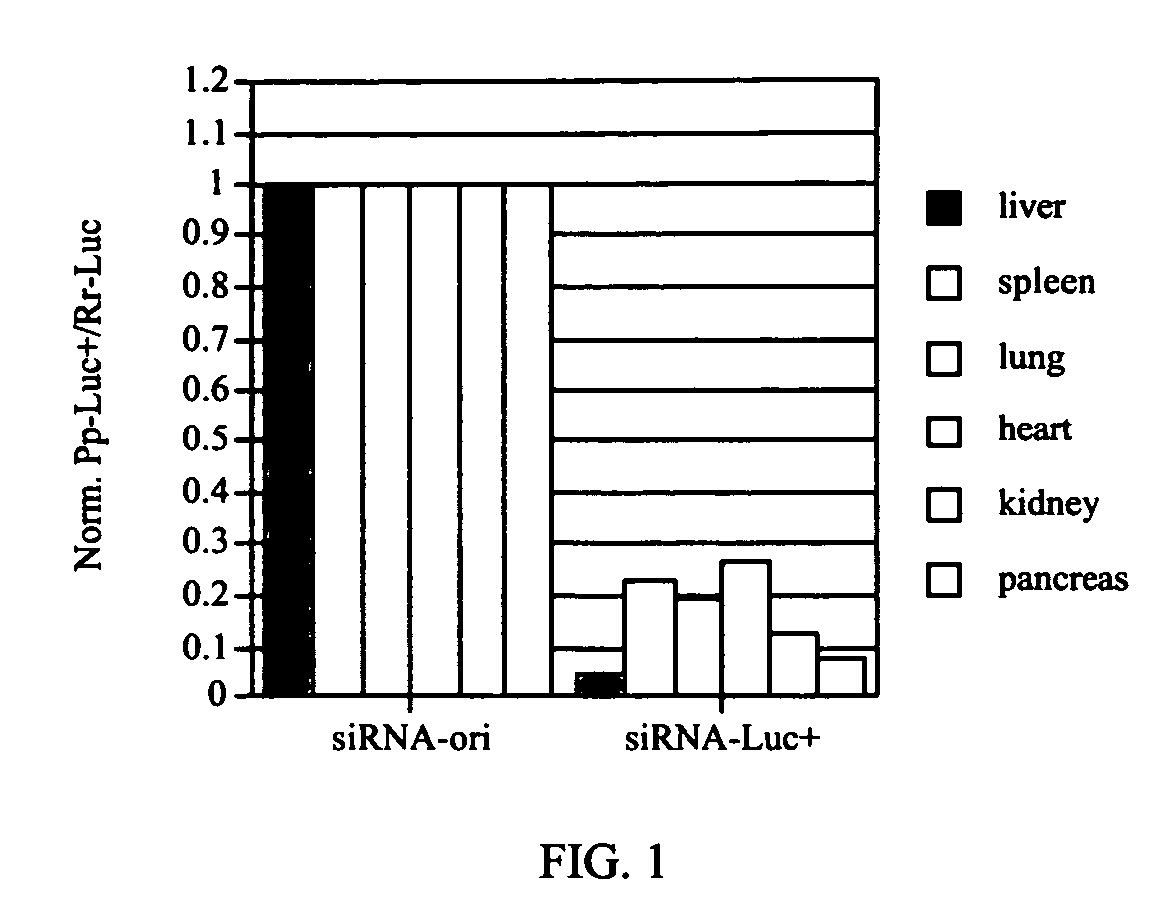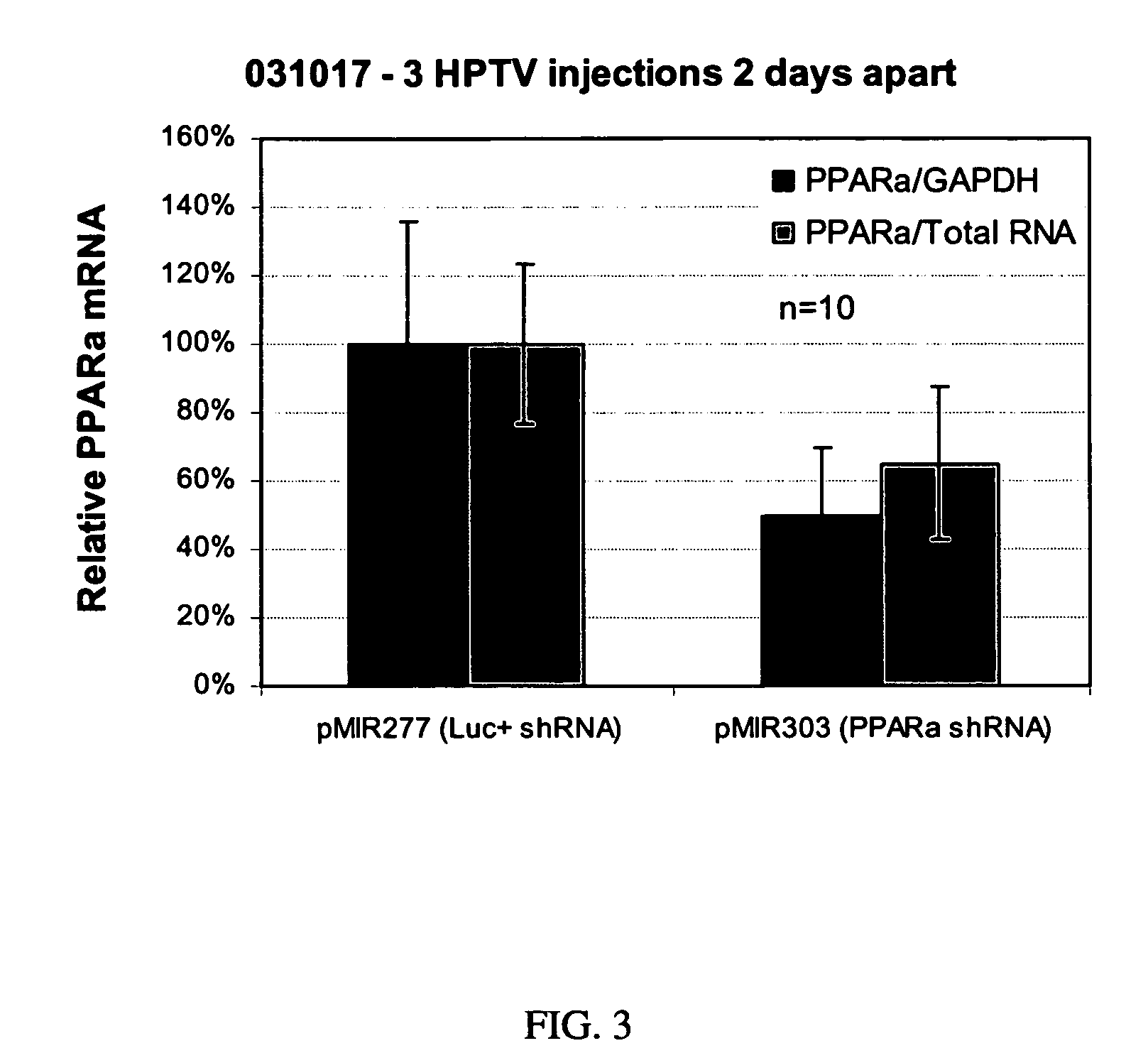In vivo inhibition of hepatitis B virus
a technology of hepatitis b virus and in vivo inhibition, which is applied in the direction of biocide, transferase, peptide source, etc., can solve the problems of liver failure and death, difficult determination of incubation time, and ineffective treatment of hepatocellular carcinoma with chemotherapeutic agents, etc., to facilitate drug discovery or target validation
- Summary
- Abstract
- Description
- Claims
- Application Information
AI Technical Summary
Benefits of technology
Problems solved by technology
Method used
Image
Examples
example 1
[0079] Inhibition of luciferase gene expression by siRNA in liver cells in vivo. Single-stranded, gene-specific sense and antisense RNA oligomers with overhanging 3′ deoxyribonucleotides were prepared and purified by PAGE. The two oligomers, 40 μM each, were annealed in 250 μl buffer containing 50 mM Tris-HCl, pH 8.0 and 100 mM NaCl, by heating to 94° C. for 2 minutes, cooling to 90° C. for 1 minute, then cooling to 20° C. at a rate of 1° C. per minute. The resulting siRNA was stored at −20° C. prior to use.
[0080] The sense oligomer with identity to the luc+ gene has the sequence: 5′-rCrUrUrArCrGrC-rUrGrArGrUrArCrUrUrCrGrATT-3′ (SEQ ID 4), which corresponds to positions155-173 of the luc+ reading frame. The letter “r” preceding a nucleotide indicates that nucleotide is a ribonucleotide. The antisense oligomer with identity to the luc+ gene has the sequence: 5′-rUrCrGrArArGrUrArCrUrCrArGrCrGrUrArArGTT-3′ (SEQ ID 5), which corresponds to positions155-173 of the luc+ reading frame in ...
example 2
[0084] Inhibition of Luciferase expression by siRNA is gene specific in liver in vivo. Two plasmids were injected simultaneously either with or without siRNA-luc+ as described in Example 1. The first plasmid, pGL3 control (Promega Corp, Madison, Wis.), contains the luc+ coding region and a chimeric intron under transcriptional control of the simian virus 40 enhancer and early promoter region. The second, pRL-SV40, contains the coding region for the Renilla reniformis luciferase under transcriptional control of the Simian virus 40 enhancer and early promoter region.
[0085] 10 μg pGL3 control and 1 μg pRL-SV40 was injected as described in Example 1 with 0, 0.5 or 5.0 μg siRNA-luc+. One day after injection, the livers were harvested and homogenized as described in Example 1. Luc+ and Renilla Luc activities were assayed using the Dual Luciferase Reporter Assay System (Promega). Ratios of Luc+ to Renilla Luc were normalized to the no siRNA-Luc+ control. siRNA-luc+ specifically inhibited ...
example 3
[0086] Inhibition of Luciferase expression by siRNA is gene specific and siRNA specific in liver in vivo. 10 μg pGL3 control and 1 μg pRL-SV40 were injected as described in Example 1 with either 5.0 μg siRNA-luc+ or 5.0 control siRNA-ori. One day after injection, the livers were harvested and homogenized as described in Example 1. Luc+ and Renilla Luc activities were assayed using the Dual Luciferase Reporter Assay System (Promega). Ratios of Luc+ to Renilla Luc were normalized to the siRNA-ori control. siRNA-Luc+ inhibited Luc+ expression in liver by 93% compared to siRNA-ori indicating inhibition by siRNAs is sequence specific in this organ.
PUM
| Property | Measurement | Unit |
|---|---|---|
| diameter | aaaaa | aaaaa |
| volume | aaaaa | aaaaa |
| volume | aaaaa | aaaaa |
Abstract
Description
Claims
Application Information
 Login to View More
Login to View More - R&D
- Intellectual Property
- Life Sciences
- Materials
- Tech Scout
- Unparalleled Data Quality
- Higher Quality Content
- 60% Fewer Hallucinations
Browse by: Latest US Patents, China's latest patents, Technical Efficacy Thesaurus, Application Domain, Technology Topic, Popular Technical Reports.
© 2025 PatSnap. All rights reserved.Legal|Privacy policy|Modern Slavery Act Transparency Statement|Sitemap|About US| Contact US: help@patsnap.com



